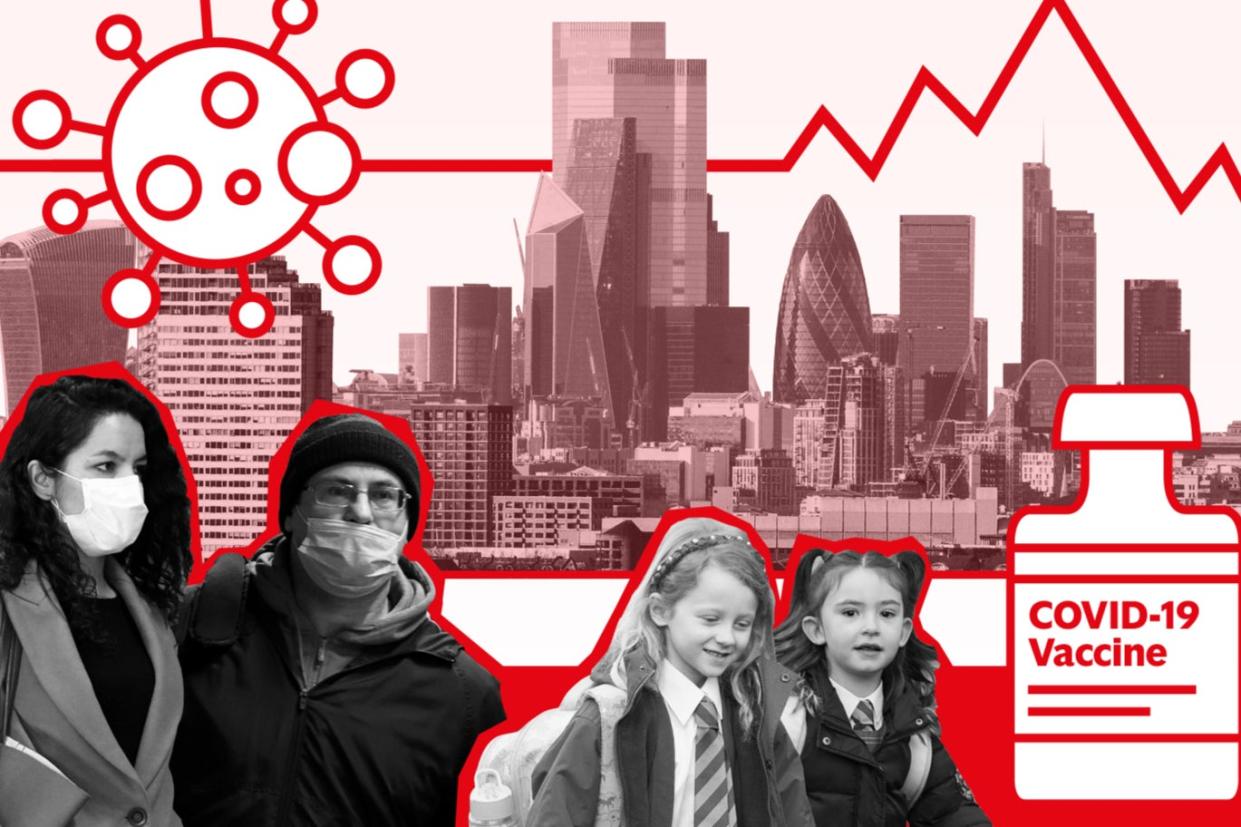London coronavirus cases by borough revealed as infection rate falls below key threshold in 29 areas

Covid-19 cases have tumbled so fast that they are now below a seven-day rate of 50 new confirmed infections a week per 100,000 people in a swathe of inner London, official figures reveal today.
Westminster saw a seven-day rate of 47.1 in the week to February 24, Southwark 49.2, Kensington and Chelsea 44.8, Camden 48.5, Islington 46.2, with the lowest in Lewisham at 42.8.
Twenty-nine borough areas, including all of east London which was hardest hit by the second wave, have a seven-day rate below 100 new confirmed cases per 100,000.
Hounslow has the highest rate on 127.1, followed by Ealing 126.1 and Hillingdon on 100.7.
Public health chiefs in London want the whole of the capital to get below a rate of 100 before restrictions start to be eased on March 8, with schools re-opening, and the city appears on track to achieve this goal.
Coronavirus levels are now significantly lower across southern England, all regions below a rate of 100, compared to the Midlands and parts of the North.
London’s seven-day rate was 70.5 as of February 24, down 22.5 per cent in a week, with the South East on 69.3 down 19.8 per cent, the South West 59.1 down 22.6 per cent and the Eastern region 84.3 down 19.6 per cent.
The North East saw the biggest drop of 24.9 per cent to 118.3, with the North West down 18.8 per cent to a rate of 133.4, Yorkshire and the Humber down 6.4 per cent to 141.9, the West Midlands down 17.4 per cent to 137.4, and the East Midlands down 15 per cent to 153.3.
Graham Medley, Professor of infectious disease modelling at the London School of Hygiene and Tropical Medicine, who chairs the Scientific Pandemic Influenza group on Modelling which advises the Government but speaking in a personal capacity, told BBC Radio on Monday: “We are already seeing and when we start opening up we will see more variation in terms of prevalence around different parts of the country and at the moment all the thinking that I have seen, but I’m sure there is others, has been largely national in terms of thinking about what the data are that we need to guide the process of releasing these measures.
“But the data will show different things in different parts of the country, so the challenge will be what do you do in terms of opening things up when in one place it says it is a good idea and in another place that it says it isn’t.”
In London, the biggest fall in confirmed cases was in Kingston in the week to February 24, down 50.5 per cent, followed by Kensington and Chelsea 47.8 per cent and Waltham Forest 42.9.
The real number of cases, though, is significantly higher than the confirmed totals, partly because so many people have the disease asymptomatically.
The disease’s decline has also slowed markedly in the capital, down from a weekly fall of more than 42 per cent last month.
Health chiefs say as disease levels get lower it is likely to get harder to drive cases down further as many of the people still at risk of catching the virus are the most difficult to protect, for example, because they are key workers or are unable to work from home.
In Islington the number of confirmed cases nudged up by two in the week to February 24, or 1.8 per cent, and in Tower Hamlets by one or 0.6 per cent, with the seven-day rate there 54.5.
The full figures for London show that:
* Kingston saw 92 cases in the week to February 24, down 94 (50.5%) with a seven-day rate of 51.8
* Kensington and Chelsea 70 cases, down 64 (47.8%) rate 44.8
*Waltham Forest 153 cases, down 115 (42.9%) rate 55.2
* Newham 246 cases, down 123 (33.3%) rate 69.7
* Hillingdon 309 cases, down 146 (32.1%) rate 100.7
* Lambeth 188 cases, down 87 (31.6%) rate 57.7
* Redbridge 230 cases, down 103 (30.9%) rate 75.4
* Lewisham 131 cases, down 58 (30.7%) rate 42.8
* Barking and Dagenham 201 cases, down 85 (29.7%) rate 94.4
* Wandsworth 193 cases, down 79 (29%) rate 58.5
* Merton 175 cases, down 69 (28.3%) rate 84.7
* Bexley 169 cases, down 61 (26.5%) rate 68.1
* Havering 180 cases, down 57 (24.1%) rate 69.4
* Southwark 157 cases, down 49 (23.8%) rate 49.2
* Haringey 166 cases, down 50 (23.1%) rate 61.8
* Enfield 190 cases, down 50 (20.8%) rate 56.9
* Camden 131 cases, down 33 (20.1%) rate 48.5
* Hounslow 345 cases, down 72 (17.3%) rate 127.1
* Brent 318 cases, down 65 (17%) rate 96.4
* Croydon 299 cases, down 61 (16.9%) rate 77.3
* Barnet 298 cases, down 59 (16.5%) rate 75.3
* Ealing 431 cases, down 79 (15.5%) rate 126.1
* Westminster 123 cases, down 22 (15.2%) rate 47.1
* Richmond 113 cases, down 18 (13.7%) rate 57.1
* Hackney and City of London 170 cases, down 26 (13.3%) rate 58.5
* Bromley 178 cases, down 27 (13.2%) rate 53.6
* Sutton 176 cases, down 23 (11.6%) rate 85.3
* Harrow 250 cases, down 32 (11.3%) rate 99.5
* Greenwich 180 cases, down 19 (9.5%) rate 62.5
* Hammersmith and Fulham 170 cases, down 12 (6.6%) rate 91.8
* Tower Hamlets 177 cases, up 1 (0.6%) rate 54.5
* Islington 112 cases, up 2 (1.8%) rate 46.2
Read More
Delaying second jab ‘saved lives’ as MPs told to prepare for tax rises
NHS has shortage of intensive care beds, hospital leaders warn

 Yahoo News
Yahoo News 
